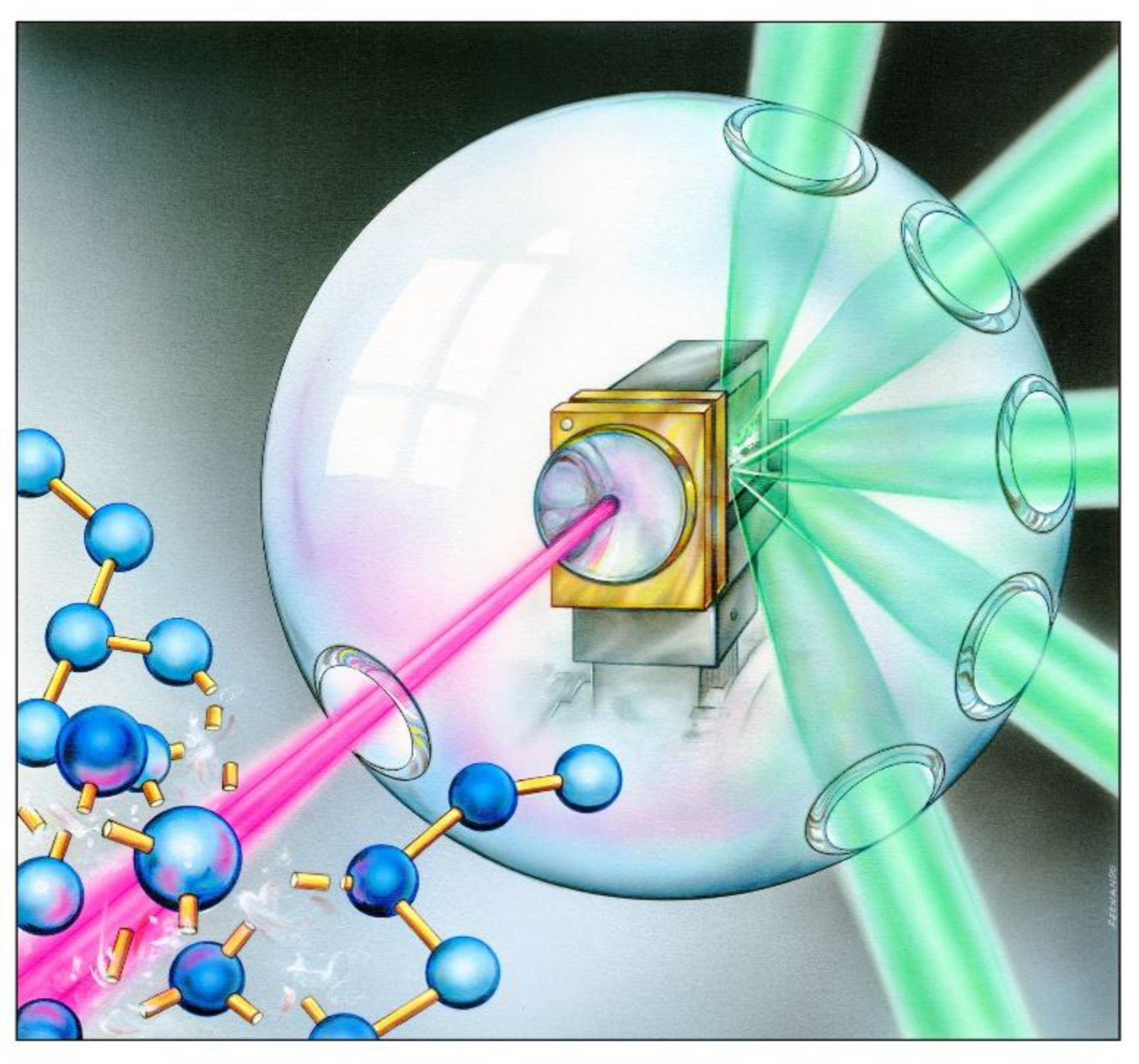Chemical Consequences of XUV/X-ray Laser-Matter Interactions
Funding
Conflicts of Interest
References
- Matthews, D.L.; Hagelstein, P.L.; Rosen, M.D.; Eckart, M.J.; Ceglio, N.M.; Hazi, A.U.; Medecki, H.; MacGowan, B.J.; Trebes, J.E.; Whitten, B.L.; et al. Demonstration of a soft X-ray amplifier. Phys. Rev. Lett. 1985, 54, 110–113. [Google Scholar] [CrossRef] [PubMed]
- Nilsen, J.; MacGowan, B.J.; Da Silva, L.B.; Moreno, J.C. Prepulse technique for producing low-Z Ne-like X-ray lasers. Phys. Rev. A. 1993, 48, 4682–4685. [Google Scholar] [CrossRef] [PubMed]
- Rocca, J.J.; Shlyaptsev, V.; Tomasel, F.G.; Cortázar, O.D.; Hartshorn, D.; Chilla, J.L.A. Demonstration of a discharge pumped table-top soft-X-ray laser. Phys. Rev. Lett. 1994, 54, 2192–2195. [Google Scholar] [CrossRef] [PubMed] [Green Version]
- Benware, B.R.; Macchietto, C.D.; Moreno, C.H.; Rocca, J.J. Demonstration of a high average power tabletop soft X-ray laser. Phys. Rev. Lett. 1998, 81, 5804–5807. [Google Scholar] [CrossRef] [Green Version]
- Ayvazyan, V.; Baboi, N.; Bohnet, I.; Brinkmann, R.; Castellano, M.; Castro, P.; Catani, L.; Choroba, S.; Cianchi, A.; Dohlus, M.; et al. Generation of GW radiation pulses from a VUV free-electron laser operating in the femtosecond regime. Phys. Rev. Lett. 2002, 88, 104802. [Google Scholar] [CrossRef] [PubMed] [Green Version]
- Ackerman, W.; Asova, G.; Ayvazyan, V.; Azima, A.; Baboi, N.; Bähr, J.; Balandin, V.; Beutner, B.; Brandt, A.; Bolzmann, A.; et al. Operation of a free-electron laser from the extreme ultraviolet to the water window. Nat. Phot. 2007, 1, 336–342. [Google Scholar] [CrossRef]
- Emma, P.; Akre, R.; Arthur, J.; Bionta, R.; Bostedt, C.; Bozek, J.; Brachmann, A.; Bucksbaum, P.; Coffee, R.; Decker, F.J.; et al. First lasing and operation of an angstrom-wavelength free-electron laser. Nat. Phot. 2007, 4, 641–647. [Google Scholar] [CrossRef]
- Callegari, C.; Grum-Grzhimailo, A.N.; Ishikawa, K.L.; Prince, K.C.; Sansone, G.; Ueda, K. Atomic, molecular and optical physics applications of longitudinally coherent and narrow bandwidth Free-Electron Lasers. Phys. Rep. 2021, 904, 1–59. [Google Scholar] [CrossRef]
- Rosenzweig, J.B.; Majernik, N.; Robles, R.R.; Andonian, G.; Camacho, O.; Fukasawa, A.; Kogar, A.; Lawler, G.; Miao, J.; Musumeci, P.; et al. An ultra-compact X-ray free-electron laser. New. J. Phys. 2020, 22, 093067. [Google Scholar] [CrossRef]
- Jaeglé, P. Le laser à rayons X. La Recherche. 1985, 18, 16–24. [Google Scholar]
- Juha, L.; Krása, J.; Cejnarova, A.; Chvostova, D.; Vorlíček, V.; Krzywinski, J.; Sobierajski, R.; Andrejczuk, A.; Jurek, M.; Klinger, D.; et al. Ablation of various materials with intense XUV radiation. Nucl Instrum. Meth. Phys. Res. 2003, A507, 277–581. [Google Scholar]
- Burian, T.; Chalupský, J.; Hájková, V.; Toufarová, M.; Vorlíček, V.; Hau-Riege, S.; Krzywinski, J.; Bozek, J.D.; Bostedt, C.; Graf, A.T.; et al. Subthreshold erosion of an organic polymer induced by multiple shots of an X-ray free-electron laser. Phys. Rev. Appl. 2020, 14, 034057. [Google Scholar] [CrossRef]

Publisher’s Note: MDPI stays neutral with regard to jurisdictional claims in published maps and institutional affiliations. |
© 2021 by the author. Licensee MDPI, Basel, Switzerland. This article is an open access article distributed under the terms and conditions of the Creative Commons Attribution (CC BY) license (https://creativecommons.org/licenses/by/4.0/).
Share and Cite
Juha, L. Chemical Consequences of XUV/X-ray Laser-Matter Interactions. Molecules 2021, 26, 6833. https://doi.org/10.3390/molecules26226833
Juha L. Chemical Consequences of XUV/X-ray Laser-Matter Interactions. Molecules. 2021; 26(22):6833. https://doi.org/10.3390/molecules26226833
Chicago/Turabian StyleJuha, Libor. 2021. "Chemical Consequences of XUV/X-ray Laser-Matter Interactions" Molecules 26, no. 22: 6833. https://doi.org/10.3390/molecules26226833
APA StyleJuha, L. (2021). Chemical Consequences of XUV/X-ray Laser-Matter Interactions. Molecules, 26(22), 6833. https://doi.org/10.3390/molecules26226833



